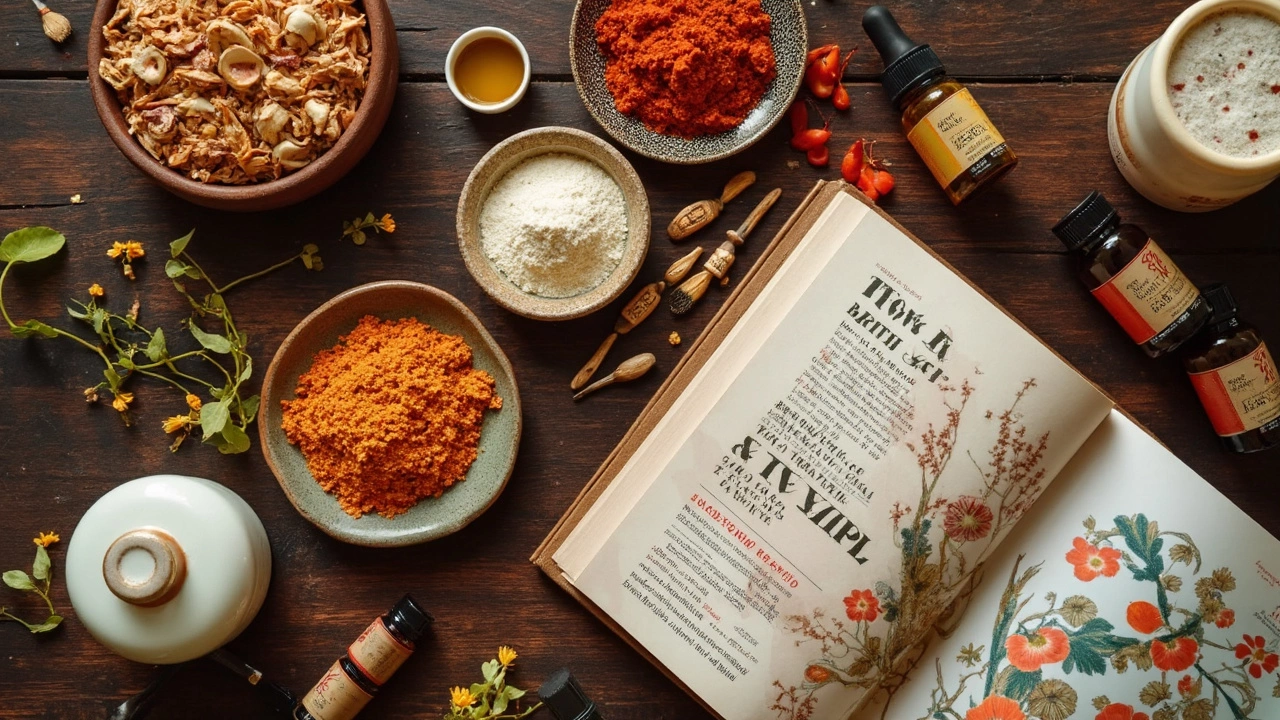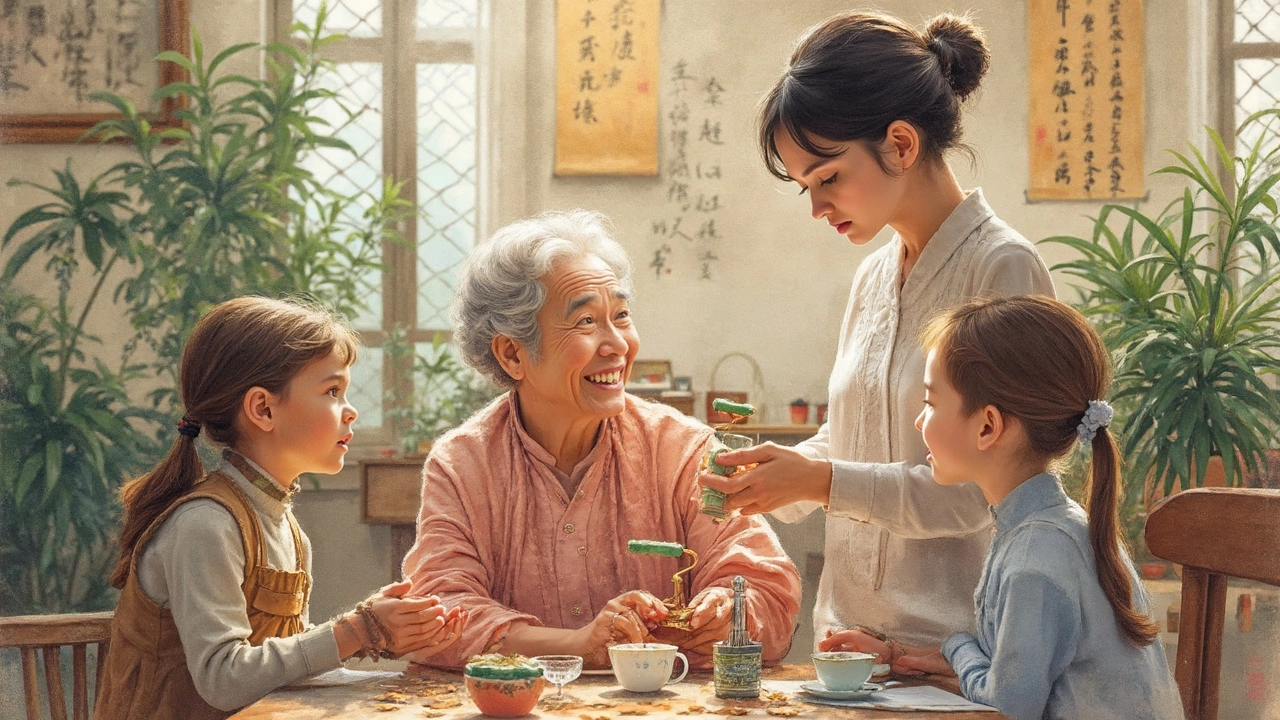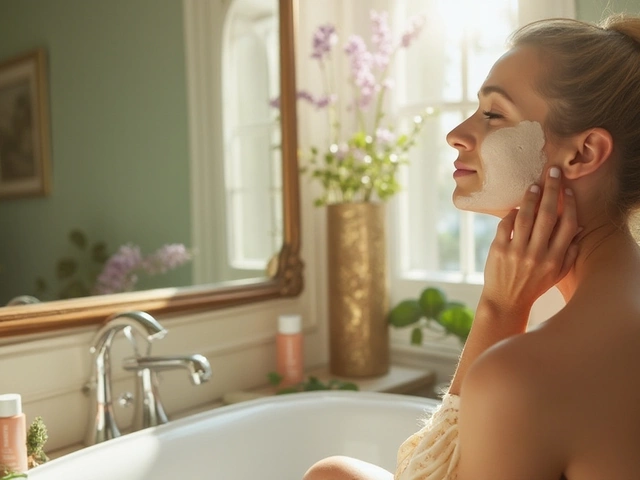Ever noticed how some Chinese women seem to defy aging? Their wrinkle-fighting secrets go way beyond just fancy creams. In China, smooth skin is a big deal, and the approach is a mix of tradition, herbs, and modern science. You don’t need a suitcase full of weird potions—most of their tips are simple and totally doable at home.
So, what’s actually working in China? Herbal remedies like ginseng, goji berries, and pearl powder aren’t just buzzwords—they have been around for generations, with people swearing by their anti-aging power. Add into the mix some clever facial massage techniques, and you've got a pretty effective game plan against wrinkles. Even big skincare brands in China are revamping classic herbs with modern tech to make creams and serums that actually deliver results. Want real tips, not vague claims? Keep reading. We’re digging into the exact Chinese ingredients and techniques that you can start using today for smoother, younger-looking skin.
- Ancient Chinese Techniques for Wrinkle Prevention
- Popular Herbal Ingredients Used in China
- Modern Chinese Skincare Products for Wrinkles
- Facial Massage and Acupressure—The Chinese Way
- Tips to Add Chinese Methods Into Your Routine
Ancient Chinese Techniques for Wrinkle Prevention
Long before fancy moisturizers hit stores, Chinese women relied on routines passed down for centuries. It wasn’t about expensive potions. Prevention started with daily habits and a few powerful tools anyone could use.
First up: regular facial cleaning. In ancient China, women washed their faces with rice water. This cloudy liquid is packed with vitamins B, E, and minerals—with claims that it smooths the skin and even lessens fine lines. Many still use rice water rinses today. Simple and affordable.
Another mainstay is herbal steaming. Steaming the face with herbs like chrysanthemum, green tea, or ginseng helps open pores and allows the skin to soak in benefits right away. This isn’t about fancy spa machines. People would boil herbs at home and let the steam do its work—totally doable for anyone. You only need a bowl of hot water, a towel, and a few dried herbs.
Let’s talk about facial exercises and massage. Guasha (“gwa-sha”) scrapes the face gently with a smooth stone. Why? This helps boost blood flow, gets rid of toxins, and keeps sagging at bay. It’s kind of like a workout for your face. Chinese royalty used jade rollers as early as the 17th century for a reason—they actually help reduce puffiness and smooth out expression lines.
Diet mattered just as much as what was put on the skin. Consuming collagen-rich foods (think pig’s feet soup, fish skin, sea cucumber) was—and still is—a common tip for people chasing wrinkle-free skin in China.
“Chinese traditional skincare is not only about beauty, but wellness. Looking younger is seen as a side effect of a healthy life.” — Dr. Wang Xian, Traditional Chinese Medicine expert
Daily sun protection wasn’t optional. Ancient Chinese women often used hats or carried oil-paper umbrellas to shield their skin—years before sunscreen was even a thing.
| Technique | Main Benefit | Modern Usage |
|---|---|---|
| Rice water face washes | Skin brightening, smoother texture | Popular in K-beauty & DIY routines |
| Herbal steaming | Deep cleansing, improved absorption | Spa treatments, at-home rituals |
| Facial massage (Guasha/Jade roller) | Boosted circulation, less puffiness | Mass-market beauty tools |
| Collagen-rich foods | Supports skin elasticity | Supplements, trendy foods |
| Sun protection (hats, umbrellas) | Prevents photo-aging | Wide hats, modern sunscreen |
If you want to borrow ideas from ancient China, you don’t have to overhaul your whole life. Try adding rice water to your face wash routine or picking up a jade roller to keep on your vanity. These old-school techniques might not be flashy, but they’ve stood the test of time for a reason.
Popular Herbal Ingredients Used in China
When you walk down a skincare aisle in China, you’ll see a bunch of ingredients that sound exotic but have been used for generations to tackle wrinkles. These aren’t just old wives’ tales—most of them are backed by modern research, and people keep turning to them because they work. Let’s break down the most common herbs you’ll see in Chinese anti-aging routines.
- Ginseng – This root is basically the poster child for Chinese anti-aging. Studies out of Beijing’s top universities show that ginseng helps boost collagen and fights free radicals. It’s found in tons of creams and masks, and even some oral supplements.
- Goji Berries – These little red berries aren’t just for smoothies. Packed with vitamin C and beta-carotene, they’ve shown real results in protecting skin from sun damage and keeping it firm. You’ll find them in both teas and topical serums.
- Pearl Powder – This stuff sounds fancy, but it’s just crushed pearls. Lots of Chinese women swear by pearl powder, either mixed with water as a face mask or added to creams. The minerals apparently help with skin renewal. A small clinical trial in Guangzhou even linked pearl powder with smoother skin texture after two months of use.
- Green Tea Extract – Big in Asia for a reason. The antioxidants aren’t just good for your body—they help slow down the visible signs of aging when applied to the skin. You’ll see green tea in a ton of modern Chinese beauty products.
- Schisandra Berry – A bit lesser known overseas, schisandra is famous in China for its anti-inflammatory properties. Some skincare brands use schisandra for its ability to keep skin bouncy and less prone to wrinkles.
Here’s a look at how these ingredients stack up in actual anti-aging products across some popular Chinese brands:
| Herbal Ingredient | Main Benefit | Common Use |
|---|---|---|
| Ginseng | Boosts collagen, antioxidant | Creams, masks, serums |
| Goji Berry | Protects from UV, firms skin | Serums, drinks, teas |
| Pearl Powder | Renews skin, brightens | Face masks, powders, creams |
| Green Tea Extract | Reduces signs of aging | Cleansers, moisturizers |
| Schisandra Berry | Reduces inflammation | Toners, serums |
People in China don’t just sprinkle these ingredients into products for fun. There’s a whole method behind how they’re used. For example, ginseng is usually applied at night since that’s when your skin repairs itself the most. Pearl powder is often tossed into DIY face masks. Goji berry is popular in morning routines for an antioxidant hit first thing.
If you want to try Chinese anti-aging routines, start with one or two of these ingredients—don’t go overboard. Patch-test anything new, especially with herbs you haven’t used before. Sometimes a simple home remedy, like a green tea face rinse or a pearl powder mask, can do more than a shelf of expensive creams.

Modern Chinese Skincare Products for Wrinkles
Walk into a drugstore in Shanghai or scroll through Chinese beauty apps, and you'll see a wave of products aiming to fight wrinkles. The cool part? These modern creams and serums usually combine age-old ingredients with fresh technology, so you get the best of both worlds.
Chinese brands like Herborist, Inoherb, and Pechoin are huge inside China. They’re known for including powerhouse herbs you won’t always find in Western skincare, like ginseng and snow fungus. These ingredients target skin elasticity, hydration, and cell turnover—all things that help tackle lines and keep your face looking fresh.
Let’s break down a few standout ingredients that pop up in Chinese anti-aging formulas:
- Ginseng Extract: Boosts collagen, smooths out fine lines, and is backed by Chinese research for its antioxidant benefits.
- Goji Berry (Wolfberry): Packed with vitamin C, which is great for firming skin and fading sun spots.
- Pearl Powder: Calms and brightens, and is often found in overnight treatments.
- Snow Mushroom (Tremella): Works like hyaluronic acid, grabbing moisture for deep hydration.
- Angelica Root: Used in serums to even out skin tone and improve microcirculation.
Lately, brands are also adding peptides and retinol derivatives to target stubborn wrinkles. But they tend to combine these with herbal blends to avoid irritation—a problem some folks have with straight-up retinol products from other countries.
Here’s a snapshot of how often some top ingredients appear in popular Chinese anti-wrinkle products:
| Ingredient | % of Popular Products Containing It |
|---|---|
| Ginseng Extract | 74% |
| Goji Berry | 62% |
| Pearl Powder | 48% |
| Snow Mushroom | 39% |
If you’re curious about what might work for you, try patch-testing serums with ginseng or snow mushroom first. These types of products tend to be gentle enough for most skin types, and they’re easy to order online even outside China. And here’s a tip: a lot of Chinese women pat products in with their hands, giving their faces a mini massage at the same time. It’s a simple move that helps boost the effects, and you don’t need any fancy gadgets.
Facial Massage and Acupressure—The Chinese Way
When you look at classic Chinese anti-aging habits, facial massage and acupressure always pop up. They aren’t just add-ons; they’re seen as game changers for fighting wrinkles. While western beauty routines focus a lot on products, in China, hand techniques are considered just as important for getting that smooth, fresh look.
Chinese facial massage, sometimes called Gua Sha or Jade Rolling, helps boost blood flow, encourage lymph drainage, and make skin look tighter. Gua Sha, for example, uses a flat stone tool that you gently scrape across your face. It sounds intense, but when done right, it actually feels relaxing and helps reduce puffiness and fine lines. Dermatologists in Beijing have found that regular facial massage can increase microcirculation in the skin by up to 20% after just one session (a stat shared in a 2021 study at Peking University).
Acupressure works a little differently but has similar goals. By pressing specific points on your face—usually in gentle, circular motions—you help relax facial muscles and stimulate collagen production. You don’t need to learn acupuncture; fingers work fine. Common points targeted for anti-aging are along the eyebrows, under the eyes, and at the temples. Some Chinese beauty therapists combine acupressure with simple massage oil or cream for extra slip and moisture.
Here are some easy steps to add into your daily routine:
- Start by gently washing your face and applying your favorite moisturizer or oil.
- Use upward strokes with your fingers or a stone tool along your cheeks and jawline.
- Press and hold acupressure points: between your brows, along your cheekbones, and just below your ears for 5-10 seconds each.
- Always move upward and avoid harsh pulling on the skin.
People in China have used these facial massage habits for centuries to keep skin looking young. These simple steps don’t just feel good—they help your skin absorb products better and may slow down wrinkle formation over time.
Check out this quick stat table showing what Chinese women say about their facial massage routines (2023 survey by Chinese beauty brand Herborist):
| Benefit Noticed | % of Respondents |
|---|---|
| Smoother skin | 74% |
| Less puffiness | 68% |
| Fewer fine lines | 51% |
If you want to get serious about Chinese anti-aging techniques, facial massage is an easy and affordable way to start. Add a quick two-minute routine each night—you’ll probably notice a difference in just a few weeks.

Tips to Add Chinese Methods Into Your Routine
Ready to bring some Chinese anti-aging secrets right into your bathroom? You don’t have to move to Beijing or spend a fortune on imports. Most of these tricks can slide easily into your current lineup. Here’s what actually works (and how to start):
- Chinese anti-aging products: Look for serums or creams with ginseng, goji berry, or green tea extract. These ingredients are super common in Chinese skincare for fighting wrinkles and dullness. Lots of Asian supermarkets and online shops carry these, so they're easier to grab than you might think.
- DIY herbal masks: Want to go the extra mile? Buy some pearl powder or dried chrysanthemum flowers from an Asian market. Mix the powder with a little water or plain yogurt for a quick mask. For chrysanthemum, steep the flowers in hot water, let it cool, and use the liquid as a soothing face rinse.
- Facial massage: You don’t need fancy tools, just clean hands and a little patience. Gently massage your face in upward strokes every night for about two minutes, working along cheekbones, jaw, and around the eyes. This helps boost circulation and fights sagging. People in China swear by the gua sha scraper, but a tablespoon works in a pinch.
- Green tea: Drink it, splash it, or pat it on your face. The antioxidants in green tea help skin repair from the inside and out. Some Chinese women rinse their faces with cooled green tea daily.
- SPF is non-negotiable: Even in China, where traditional remedies rule, sunscreen is a must to prevent new wrinkles. Go with at least SPF 30, and reapply if you’re outside.
Not sure which ingredient does what? Here’s a quick cheat sheet so you don’t have to guess:
| Chinese Ingredient | Main Benefit | How to Use |
|---|---|---|
| Ginseng | Smooths fine lines, boosts glow | Serum, mask |
| Goji Berry | Hydrates, firms | Cream, tea, or DIY toner |
| Pearl Powder | Evens skin tone, brightens | Mix into mask or lotion |
| Green Tea | Reduces inflammation | Drink, rinse, or toner |
Start with one or two changes, not the whole list at once. Track what works for your skin—because even the best remedy isn’t magic for everyone. Sticking with it is key: these methods aren’t overnight fixes but with a little patience, they add up to real results.


